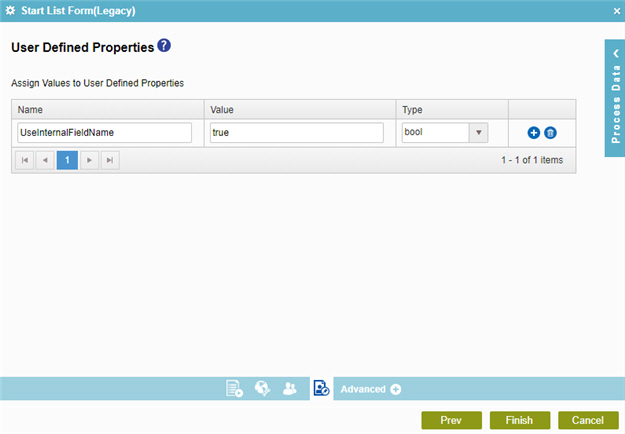Start List Form activity
An activity that shows a form made with a SharePoint list that lets a user start a process.

Configure the Start List Form activity
To configure the Start List Form activity, do the procedure in this topic.
Video: Using SharePoint List Forms with AgilePoint
Examples
Prerequisites
- Create an Application to Start from SharePoint.
This activity only shows in Process Builder if the app starts from SharePoint.
Good to Know
- To send an e-mail notification, click
Advanced
 >
E-mail Notifications
>
E-mail Notifications  .
. For more information, refer to Configure E-mail Notifications for Any Activity.
- In most text fields, you can use process data variables as an alternative to literal data values.
- The Standard List Form activity and Start List Form activity can not be used on the lists where forms-based application is created. The List Form activities are only for legacy applications.
- Some information about third-party integrations is outside the scope of the AgilePoint NX Product Documentation, and it is the responsibility of the vendors who create and maintain these technologies to provide this information. This includes specific business uses cases and examples; explanations for third-party concepts; details about the data models and input and output data formats for third-party technologies; and various types of IDs, URL patterns, connection string formats, and other technical information that is specific to the third-party technologies. For more information, refer to Where Can I Find Information and Examples for Third-Party Integrations?
How to Start
- On the Application Explorer screen, do one of these:
- Do one of these:
- Add an activity:
- In the Process Builder, go to the Activity Library, and
open the SharePoint
 tab.
tab. - On the SharePoint
 tab,
drag the Start List Form
tab,
drag the Start List Form  activity onto your process.
activity onto your process.
- In the Process Builder, go to the Activity Library, and
open the SharePoint
- Change an activity:
- In your process, double-click your activity.
- Add an activity:
List Form Configuration
Specifies if the fields on a SharePoint List Form are editable, read-only, or hidden.

Fields
| Field Name | Definition |
|---|---|
|
SharePoint |
|
|
Site URL |
|
|
List |
|
Show All Fields |
|
|
Field Name |
|
|
Field Type |
|
|
Editable |
|
|
Read Only |
|
|
Hidden |
|
General Configuration
Specifies the basic settings for the Start List Form activity.

Fields
| Field Name | Definition |
|---|---|
|
Display Name |
|
|
Description |
|
|
Time to Complete |
|
|
Priority |
|
Participants

Fields
| Field Name | Definition |
|---|---|
|
Details |
|
|
Participant Type list |
|
|
Search |
|
|
The maximum number of participants to complete this task |
|
|
Assign task to the same participants each time activity runs |
|
User Defined Properties
Specifies ClientData process data variable values that are associated with a human task activity when a process runs. You can specify a set of variables as name/value pairs that are sent to your web forms. This is an alternative to sending data with URL parameters.

Fields
| Field Name | Definition |
|---|---|
|
Name |
|
|
Value |
|
|
Type |
|
|
Add |
|
|
Delete |
|





